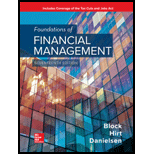
a.
To determine: The number of directors that Mr. Clark is sure of electing.
Introduction:
Cumulative Voting:
It is a voting system helpful in strengthening the rights of minor shareholders. It also allows the shareholders to cast their vote to elect the board of directors of the company.
Shares Outstanding:
They are referred to as the common shares of the authorized company, which are actually held by the investors and represent ownership of the company. They are also termed as issued shares.
a.
Answer to Problem 9P
The number of directors Mr. Clark is sure of electing while cumulative voting is practiced is 4.
Explanation of Solution
Calculation of the number of directors:
b.
To determine: The number of directors that Ms. Ramsey and friends are sure to vote for.
Introduction:
Cumulative Voting:
It is a voting system helpful in strengthening the rights of minor shareholders. It also allows the shareholders to cast their vote to elect the board of directors of the company.
Shares Outstanding:
They are referred to as the common shares of the authorized company, which are actually held by the investors and represent ownership of the company. They are also termed as issued shares.
b.
Answer to Problem 9P
The number of shares that Ms. Ramsey and friends are sure to vote for is 5.
Explanation of Solution
Calculation of the number of directors:
c.
To determine: The number of directors that can be elected by Mr. Clark if all the proxies for the votes that remain uncommitted are obtained by him as well as whether the board will be controlled by him or not.
Introduction:
Cumulative Voting:
It is a voting system helpful in strengthening the rights of minor shareholders. It also allows the shareholders to cast their vote to elect the board of directors of the company.
Shares Outstanding:
They are referred to as the common shares of the authorized company, which are actually held by the investors and represent ownership of the company. They are also termed as issued shares.
c.
Answer to Problem 9P
The number of directors that can be elected by Mr. Clark if all the proxies for the votes that remain uncommitted are obtained by him is 7.
Yes, the board will be controlled by him.
Explanation of Solution
Calculation of the number of directors:
d.
To determine: The number of directors that can be elected by Mr. Clark.
Introduction:
Cumulative Voting:
It is a voting system helpful in strengthening the rights of minor shareholders. It also allows the shareholders to cast their vote to elect the board of directors of the company.
Shares Outstanding:
They are referred to as the common shares of the authorized company, which are actually held by the investors and represent ownership of the company. They are also termed as issued shares.
d.
Answer to Problem 9P
The number of directors to be elected by Mr. Clark is 4.
Explanation of Solution
Calculation of the number of directors to be elected:
Want to see more full solutions like this?
Chapter 17 Solutions
EBK FOUNDATIONS OF FINANCIAL MANAGEMENT
- critically discuss the hockey stick model of a start-up financing. In your response, explain the model and discibe its three main stages, highlighting the key characteristics of each stage in terms of growth, risk, and funding expectations.arrow_forwardSolve this problem please .arrow_forwardSolve this finance question.arrow_forward
- solve this question.Pat and Chris have identical interest-bearing bank accounts that pay them $15 interest per year. Pat leaves the $15 in the account each year, while Chris takes the $15 home to a jar and never spends any of it. After five years, who has more money?arrow_forwardWhat is corporate finance? explain all thingsarrow_forwardSolve this finance problem.arrow_forward
 EBK CONTEMPORARY FINANCIAL MANAGEMENTFinanceISBN:9781337514835Author:MOYERPublisher:CENGAGE LEARNING - CONSIGNMENT
EBK CONTEMPORARY FINANCIAL MANAGEMENTFinanceISBN:9781337514835Author:MOYERPublisher:CENGAGE LEARNING - CONSIGNMENT
